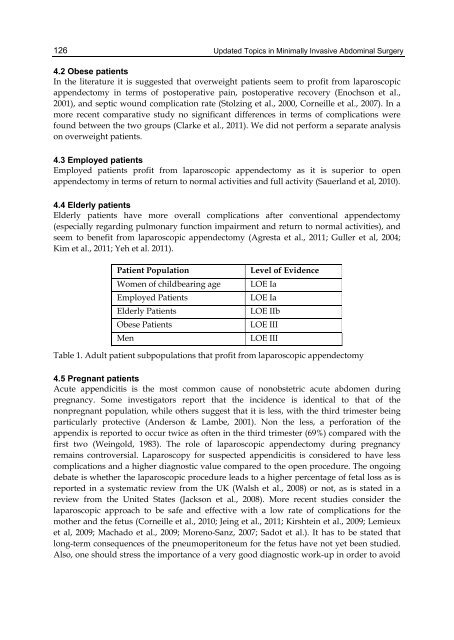UPDATED TOPICS IN MINIMALLY INVASIVE ABDOMINAL SURGERY
UPDATED TOPICS IN MINIMALLY INVASIVE ABDOMINAL SURGERY
UPDATED TOPICS IN MINIMALLY INVASIVE ABDOMINAL SURGERY
Create successful ePaper yourself
Turn your PDF publications into a flip-book with our unique Google optimized e-Paper software.
126<br />
Updated Topics in Minimally Invasive Abdominal Surgery<br />
4.2 Obese patients<br />
In the literature it is suggested that overweight patients seem to profit from laparoscopic<br />
appendectomy in terms of postoperative pain, postoperative recovery (Enochson et al.,<br />
2001), and septic wound complication rate (Stolzing et al., 2000, Corneille et al., 2007). In a<br />
more recent comparative study no significant differences in terms of complications were<br />
found between the two groups (Clarke et al., 2011). We did not perform a separate analysis<br />
on overweight patients.<br />
4.3 Employed patients<br />
Employed patients profit from laparoscopic appendectomy as it is superior to open<br />
appendectomy in terms of return to normal activities and full activity (Sauerland et al, 2010).<br />
4.4 Elderly patients<br />
Elderly patients have more overall complications after conventional appendectomy<br />
(especially regarding pulmonary function impairment and return to normal activities), and<br />
seem to benefit from laparoscopic appendectomy (Agresta et al., 2011; Guller et al, 2004;<br />
Kim et al., 2011; Yeh et al. 2011).<br />
Patient Population Level of Evidence<br />
Women of childbearing age LOE Ia<br />
Employed Patients LOE Ia<br />
Elderly Patients LOE IIb<br />
Obese Patients LOE III<br />
Men LOE III<br />
Table 1. Adult patient subpopulations that profit from laparoscopic appendectomy<br />
4.5 Pregnant patients<br />
Acute appendicitis is the most common cause of nonobstetric acute abdomen during<br />
pregnancy. Some investigators report that the incidence is identical to that of the<br />
nonpregnant population, while others suggest that it is less, with the third trimester being<br />
particularly protective (Anderson & Lambe, 2001). Non the less, a perforation of the<br />
appendix is reported to occur twice as often in the third trimester (69%) compared with the<br />
first two (Weingold, 1983). The role of laparoscopic appendectomy during pregnancy<br />
remains controversial. Laparoscopy for suspected appendicitis is considered to have less<br />
complications and a higher diagnostic value compared to the open procedure. The ongoing<br />
debate is whether the laparoscopic procedure leads to a higher percentage of fetal loss as is<br />
reported in a systematic review from the UK (Walsh et al., 2008) or not, as is stated in a<br />
review from the United States (Jackson et al., 2008). More recent studies consider the<br />
laparoscopic approach to be safe and effective with a low rate of complications for the<br />
mother and the fetus (Corneille et al., 2010; Jeing et al., 2011; Kirshtein et al., 2009; Lemieux<br />
et al, 2009; Machado et al., 2009; Moreno-Sanz, 2007; Sadot et al.). It has to be stated that<br />
long-term consequences of the pneumoperitoneum for the fetus have not yet been studied.<br />
Also, one should stress the importance of a very good diagnostic work-up in order to avoid














![focuspdca.ppt [Compatibility Mode]](https://img.yumpu.com/22859457/1/190x146/focuspdcappt-compatibility-mode.jpg?quality=85)


